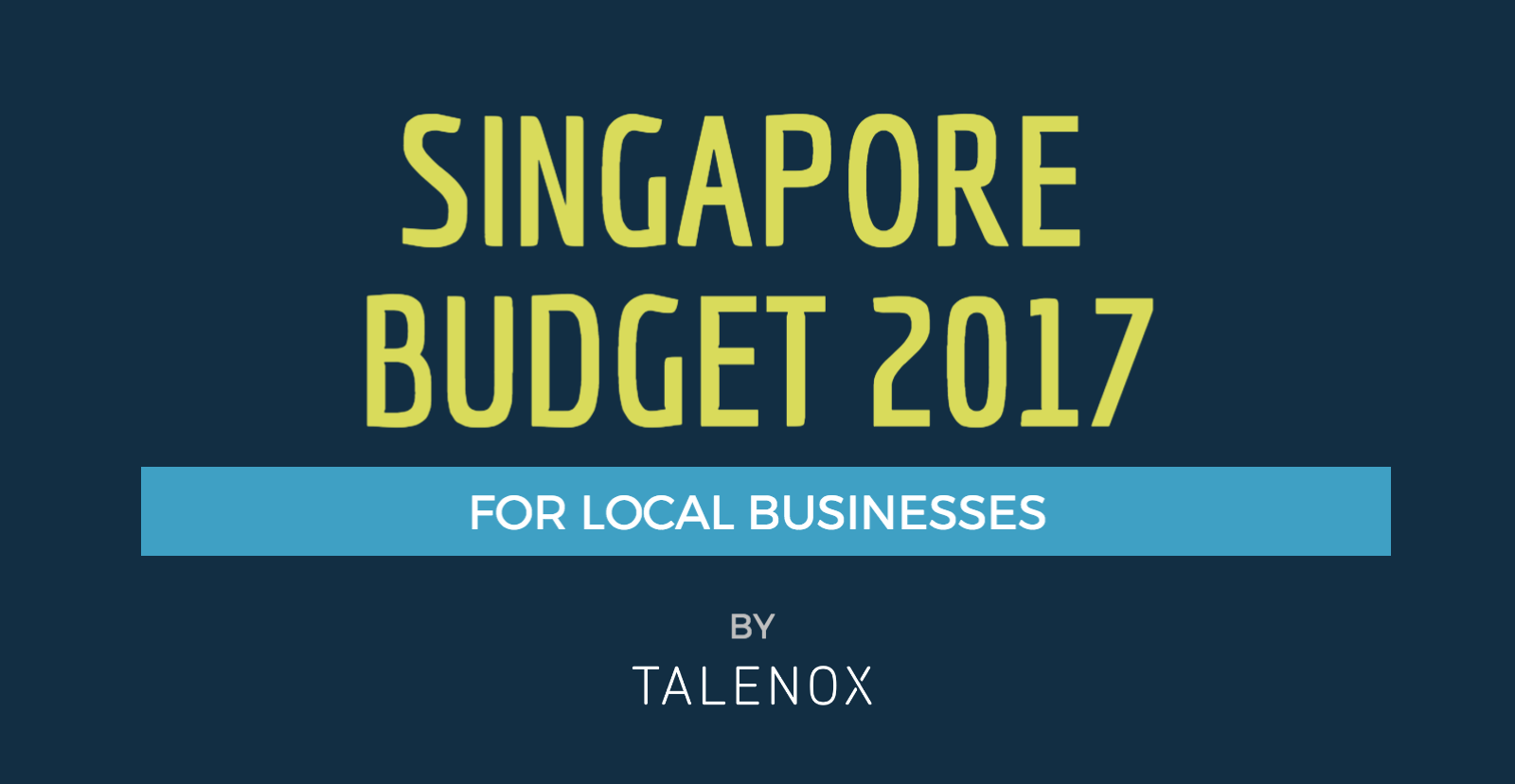On 20th February, 3.30pm, Finance Minister Heng Swee Keat announced the Government’s new initiatives and programmes during his Singapore Budget 2017 speech. Every year, the Singapore Government compiles information on government revenue and expenditure for both the current and upcoming financial year (it begins on 1 April every calendar year and ends on 31 March). The Ministry of Finance (MOF) also gathers public feedback to determine how to best allocate resources that would help its people develop new skills and attain a better quality of life.
This year, we are pleased that there are many enhancement measures in place for local businesses like ours. Budget 2017’s emphasis is very much on innovation, transition, and adaptation to the ever-changing global environment.
Once again, we’ve put together the key initiatives affecting small businesses and employees in an easy-to-understand infographic. Feel free to share it with your colleagues, family and friends. More information on the initiatives can be found below the infographic.

1. Community on the Future Economy (CFE)
$2.4 billion will be allocated to implement seven key strategies proposed by the Committee on the Future Economy (CFE), a 30-member committee formed to develop Singapore’s long-term economic blueprint to achieve an average yearly growth rate of 2-3%.
Most of us are familiar with the Industry Transformation Maps (ITMs) that was implemented last year, a $4.5 billion programme that was aimed to boost 23 industries. The additional $2.4 billion is budgeted for the remaining six strategies (not including the Industry Transformation Maps), and spending is to be spread out over the next four years.
Here are the other six strategies:
- In order to deepen and diversify Singapore’s international connections, the Government is setting aside $100 million for the Global Innovation Alliance and SkillsFuture Leadership Development Initiative. The former will have three programmes: the Innovator’s Academy (for tertiary students), Innovation Launchpads in elected overseas markets (for entrepreneurs), and Welcome Centres (for foreign companies). Local companies may leverage on the latter programme to send potential business leaders abroad to acquire deeper knowledge of regional markets.
- More emphasis on helping Singaporeans with skills upgrading and lifelong learning, such as introducing modularised programmes and online learning platforms.
- Strengthen enterprise capabilities to innovate and scale up easily, and allowing for shared capabilities between enterprises and smaller companies.
- Set up national initiatives such as the National Trade Platform and National Payments Council to promote the use of technology to businesses.
- Making Singapore a more connected city internally, such as building clusters that combine economic and social infrastructure (e.g. Jurong Innovation District).
- Increase mutual trust and cooperation between trade associations and chambers, unions, enterprises and individuals.
2. SkillsFuture movement to be enhanced
In addition to the CFE strategies, the Government will top up two funds to increase innovation and support industry transformation respectively. They are the National Research Fund (up by $500 million) and the National Productivity Fund (up by $1 billion).
3. SMEs Go Digital Programme
More than $80 million will be made available to help small businesses in Singapore utilise digital technologies in their operations. Some examples include getting more advice and funding support for emerging ICT solutions, training programs for cybersecurity professionals, and easier access to intellectual property (IP).
4. Greater push for Singapore businesses to go global
S$600 million will be injected into a new fund called the International Partnership Fund, which will help Singapore businesses with their overseas expansion efforts. In addition, there will be some enhancements to IE Singapore’s Internationalisation Finance Scheme.
5. More support for employment of older workers
The Special Employment Credit (SEC) was introduced in 2011 to raise the employability of older workers. It will be extended till end-2019. Businesses that voluntarily re-employ such workers will continue to benefit from wage offsets of up to 3% for workers who earn under $4,000 per month. This extension will benefit about 120,000 workers and 55,000 employers, and will cost about $160 million.
6. Adapt and Grow initiative for workers-in-transition
Workers that are thinking of moving to a different sector may benefit from the Adapt and Grow initiative by Workforce Singapore. This includes career coaching, wage support and training, and career conversion schemes for both employers and employees.
7. Attach-and-Train Programme for freelancers
Targeted at junior freelancers in the creative industry, this initiative is designed to provide freelancers with hands-on training and mentorship through 6-month attachments at companies. Employers will receive funding for salary payments and mentorship allowance for the freelancer.
8. Deferment of Foreign Worker Levy (FWL) hikes
The current Foreign Worker Levy (FWL) rates for the Marine and Process sectors will be carried over for one more year.
9. Continuation of the SME Working Capital Loan
The Government will continue to co-share 50% of the default risk for loans of up to $300,000 per SME. The loan will be available for the next two years.
10. Continuation of the Wage Credit Scheme
More than $600 million is expected to be paid out to businesses next month to help cope with rising costs. About 70% of this amount will be attributed to SMEs.
For more information, you may refer to the Singapore Budget 2017 website, where the full Budget statement, the full speech video, and past Budget initiatives can be accessed.
Like what you have just read? You may also be interested in:
What do the new CPF Contribution updates in 2016 mean for you? (infographic)
[Free tool] Singapore Foreign Worker Levy Calculator
Itemised Payslips for Business Owners in Singapore
[Free tool] Hong Kong’s First Contribution and Monthly Contribution MPF Calculator







[…] For more information, please refer to the Budget 2018 website. If you’d like to do a year-on-year comparison of each year’s measures, you may refer to our Budget 2017 Infographic blog post. […]